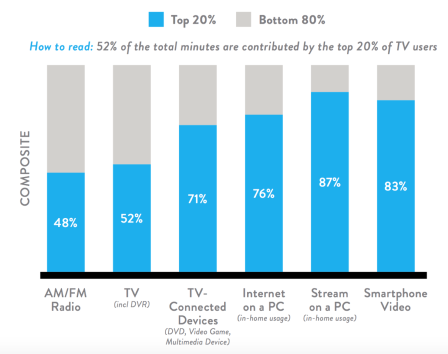Report: TV time holds but digital channels dominate for 18 – 49 year olds
In a fragmented media environment, marketers need to carefully test channels to determine which ones can effectively reach desired audiences.

Traditional “live TV” still commands the most time of any media channel, says Nielsen in its first-quarter 2016 Total Audience Report. However, it no longer dominates for the most coveted consumer segments.
The report, released earlier today, focuses on three primary areas: reach, time spent with media and audience composition. Nielsen’s legacy business is TV measurement, and the report offers support for those trying to make the case that traditional TV advertising is still relevant and powerful.
The document finds that traditional radio reaches the single largest audience, followed by TV. The report also says that smartphones now outstrip PC internet usage, in terms of monthly active users (These numbers are quite different from comScore’s).

Beyond reach, traditional TV commands the majority of daily media time in the US. Nielsen says that the average US adult spends about 4 1/2 hours per day with live TV. By comparison, mobile devices see just over two hours of engagement. This appears to contradict other data in the market (e.g., Yahoo-Flurry), which assert that more time is spent now in mobile apps than with TV.
While TV and radio audiences have remained stable, all the growth in media consumption is coming from mobile devices and PCs. Nielsen also reports that 81 percent of mobile users have smartphones.
When you slice the data by age category, a more nuanced narrative emerges. For those under 50, digital media have overtaken traditional TV for time spent. While one might argue with that assertion by combining TV time in different categories, it’s clear from the totality of the evidence that mobile devices and alternative video channels dominate among younger users.

The report also doesn’t discuss “second-screening.” In 2014, Facebook and Millward Brown published research that argued more than 70 percent of internet users actively engaged with a second screen (smartphone, tablet) during TV shows and TV ads. Understanding this dynamic is also important in assessing the effectiveness of TV as an advertising medium.
Another noteworthy set of findings in the Nielsen report relates to media consumption by power users. According to the report and chart below, the top 20 percent of users consume the bulk of media in each of the measured categories. For example, the top 20 percent of smartphone video streamers consume 83 percent of all streaming minutes in the US.

It goes without saying that we live in a highly fragmented media environment. That’s been true for a long time. But simple metrics (e.g., reach) and assumptions about traditional and digital media must be tested empirically to determine which channels are most effective to reach intended audiences.
Marketing Land – Internet Marketing News, Strategies & Tips
(34)



